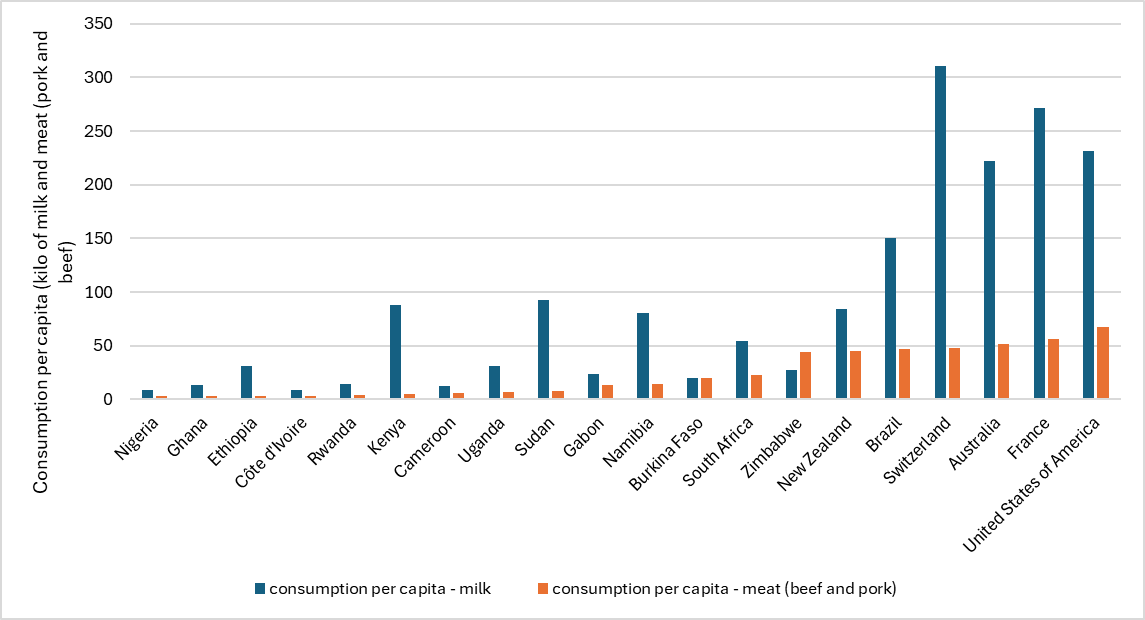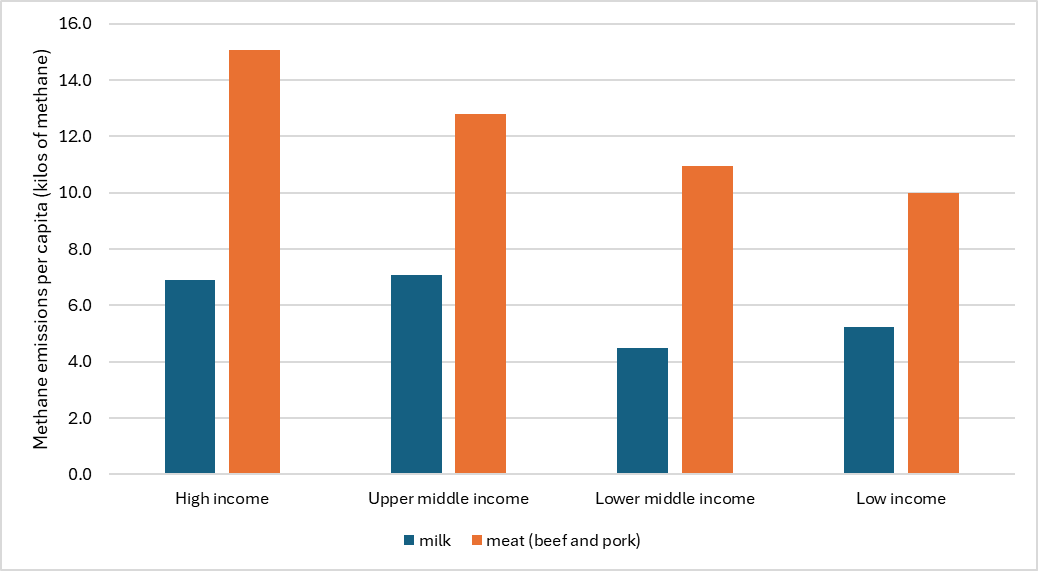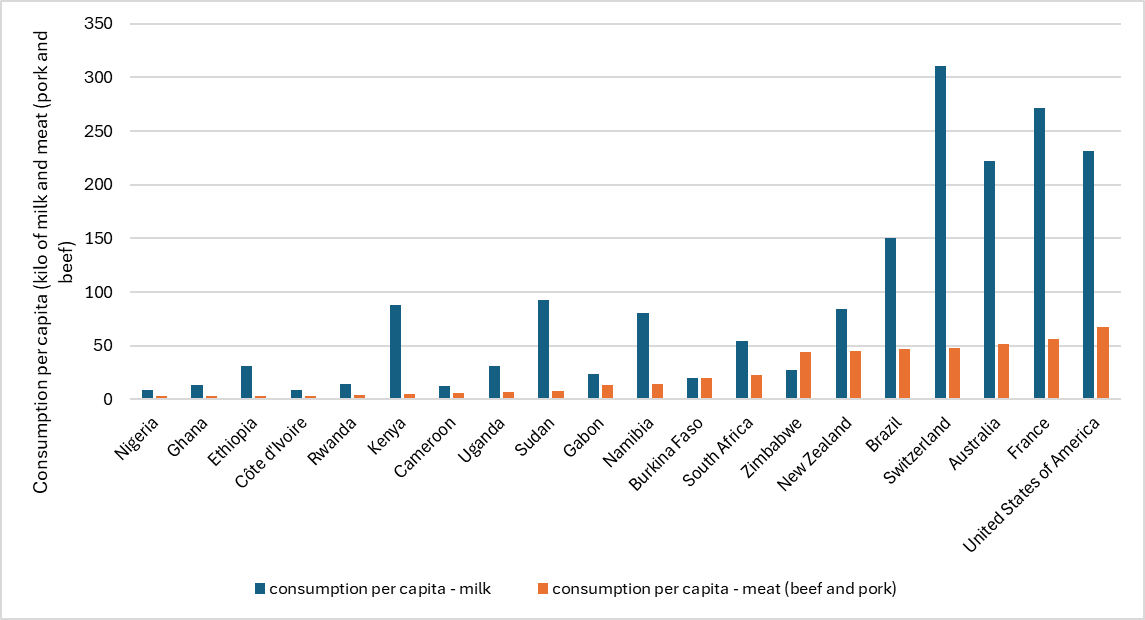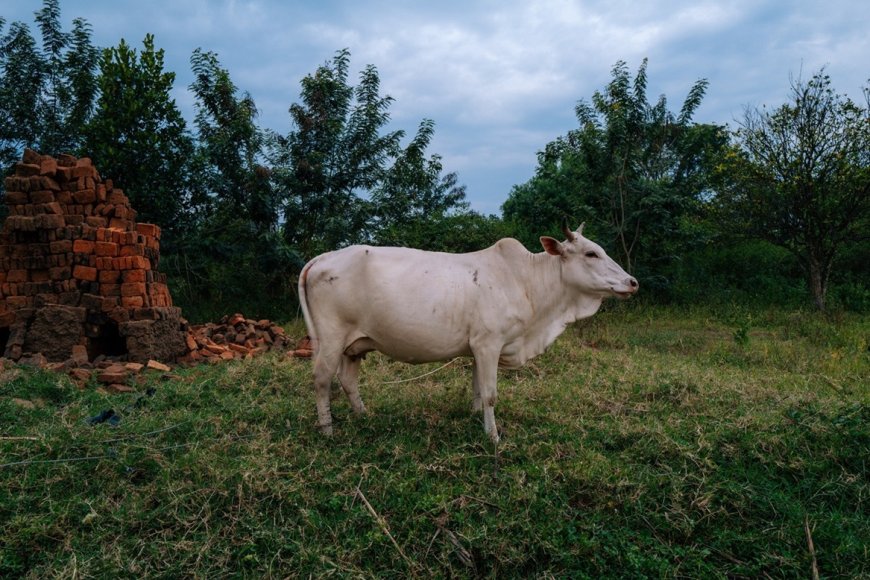Summary
- Food systems have evolved significantly over the past 60 years, contributing to a reduction in food insecurity and a dramatic decrease in poverty around the world.
- However, these systems are responsible for a significant share of greenhouse gas emissions, including methane, a potent contributor to global warming.
- Although every country bears responsibility for addressing these emissions, agriculture production and methane emissions are not equally distributed across the world.
- For this reason, it’s crucial to adopt a fair and just approach that considers the management of agriculture methane emissions while also guaranteeing country development, food security and adequate nutrition.
- Availability of methane-reducing technology and practices, global agreements, innovative national policies and access to finance are some entry points for governments to fight agriculture methane emissions.
Introduction
Global food systems have undergone an impressive transformation in the past 60 years. Improved plant and animal genetics, increased use of technology and improved management are just a few examples of practices that have led to significant increases in food production and productivity. The increased supply of agricultural products has created a more abundant food supply that has greatly reduced poverty and hunger around the world. Despite these advancements, a staggering difference in distribution and access to food still plagues us: There are over 800 million undernourished people in the world, with 12,000 dying of hunger daily, while over 2.6 billion people are overweight or obese.1
Furthermore, these food systems advances have come with massive environmental costs: Agriculture production is responsible for 40%2 of all human-made emissions of methane, a potent greenhouse gas (~80 times more potent than CO2 in a 20-year timespan). At the same time, agriculture is the sector most vulnerable to the negative effects of climate change, especially in tropical countries where small-scale farmers are likely to be disproportionately impacted.
The role of agriculture in methane production
Annually, the world emits approximately 380 million tons of human-made methane into the atmosphere. Of this, agriculture production emits ~150 million tonnes (or 40% of the total, equivalent to 4.2 billion tonnes of CO2e) per year into the atmosphere (followed by the oil, gas, and coal industry with ~32% of emissions, and food waste, responsible for ~18% of emissions).3 The main agriculture sources of methane are livestock, which emits enteric methane (73%), formed in the digestive system of ruminant animals (e.g. cattle, sheep, goats, buffaloes, camels) and expelled mainly by burping, and manure methane (7%), which is formed when manure is stored. Methane from rice production (20%) is formed when rice is grown in flooded fields, and bacteria in the soil breaks down organic matter and releases methane.
These methane emissions are not equally distributed across the world. Globally, 1.7 billion people depend directly on livestock and rice cultivation, including smallholder farmers, agro-pastoralists and pastoralists. Over 70% of those employed in the agricultural sector are women.4 5 Low- and middle-income countries have the largest concentration of livestock herds and rice production in the world; 84% of agriculture methane comes from these countries, who also house around 85% of the global population.6 7
The African continent is home to 19% of the global population but is responsible for only 13% of agriculture methane emissions.8 9 When only emissions from livestock are accounted for, high-income countries, with just 14% of global population, bear the responsibility for 22% of the emissions. This is due to the enormous difference in the consumption of animal products between wealthy and low-income countries. On average, a person in a high-income country consumes over 180 kg of dairy products per year and over 40 kg of meat (beef and pork), while a person in a low-income country consumes at least 5 times less than that amount (Figure 1). 10 11
Source: Food and Agriculture Organization (FAO). (n.d.). FAOSTAT: Emissions Total. FAO. Retrieved from https://www.fao.org/faostat/en/#data/GT

Given these disparities, the responsibility of methane emissions in the agriculture sector should not rest on countries that emit it the most. The role of consumption should also be taken into account. When we combine the highly variable agriculture production efficiency data with the massive variation in the consumption of global animal products, and then adjust for international trade, we can calculate another important metric that policymakers should account for when tackling agriculture methane: emissions per capita.
Source: Food and Agriculture Organization (FAO). (n.d.). FAOSTAT: Emissions Total. FAO. Retrieved from https://www.fao.org/faostat/en/#data/GT

As shown on the table above, high- and middle-income countries have the highest methane emissions per capita, whereas lower-income countries have the least impact. This metric is important because it helps governments design country- and region-specific policies that will account for each region’s needs. For example, governments might supply an increasing demand for animal products, which is expected to come from lower middle-income countries, while also improving agriculture efficiency.14 15
Entry points for methane mitigation in the agricultural sector
Every country shares responsibility in reducing emissions from livestock. The approaches that each one will take are different, especially because in many regions of the world, prioritisation is given to food security, access to high-quality foods and economic development. Solutions must consider economic, social and even cultural aspects of different regions of the world, especially since some countries obtain over 20% of their GDP from agriculture (e.g. Ethiopia, Rwanda, Niger, among others).16 The challenge we face is to reduce agriculture methane emissions while producing enough food and guaranteeing just access to a growing global population. Below are proposed entry points with potential to facilitate fair and just approaches.
- Technological development and production efficiency
From a technology standpoint, there are two groups of solutions to fight agriculture methane: developing methane-reducing technologies and improving the efficiency of agriculture production systems:
- Developing methane-reducing technologies. This is a fast-moving space. Current solutions involve the use of feed additives, selecting for low-emitter animals, using different rice varieties and the development of technologies such as methane-reducing vaccines and gene editing, among many others. However, as of today, many technological solutions add a significant cost to farmers without a clear direct benefit (e.g. increased animal health or milk production).17
- Improving the efficiency of agriculture production systems. Emissions intensity, or the methane emissions by unit of food produced (i.e. per kg of rice, milk, and meat), is another metric that demonstrates the importance of efficient production systems across and within different countries. For instance, in high-income countries, for every kilogram (kg) of milk produced, less than 0.1 kg of methane is emitted. On the other hand, one kg of dairy products produced in a low-income country produces over 0.4 kg of methane. The difference in producing one kg of meat is even greater: While a little over 0.2 kg of methane is emitted for every kg of beef and pork produced in a high-income country, 1.8 kg of methane is emitted when these products are produced in a low-income country (Figure 3).18 Overall, methane intensities for livestock products are six to 16 times higher in the lowest-income countries than they are in the high-income countries. Among many reasons for this difference are the quality of the feed the animals receive, differences in animal health and mortality, limited access to extension and advisory services, and limited access to animal genetics.

Source: Food and Agriculture Organization (FAO). (n.d.). FAOSTAT: Emissions Total. FAO. Retrieved from https://www.fao.org/faostat/en/#data/GT
- Policy and regulatory framework
Reducing methane emissions from agriculture is not only a technological issue, it is also a national policy, regulation and implementation challenge. A robust policy framework to support the rapid adoption of methane-reducing technologies and practices in agriculture is urgently needed not only to reduce methane emissions, but also to guarantee food security and protect the agriculture sector from the devastating effects of climate change.
However, policies directed at tackling emissions from agriculture are still nascent, with limited measurable impacts. Ideally, policies should be designed in a way that addresses food and nutrition security, supports rural development and reduces poverty.20 Some wealthy countries’ approach to the problem has been through the use of incentives, subsidies and taxation. For instance, the US has directed resources to support the development of climate-smart initiatives through the Inflation Reduction Act (IRA). The IRA also supports farmers interested in implementing climate-smart practices through a pay-for-practice approach.21 Denmark has introduced the concept of an agriculture carbon tax to meet its climate ambitions.22 In the UK, the government plans to incentivise the uptake of methane-reducing feed additives.23
Policies that support taxation or that rely on the use of subsidies and incentives work for wealthy countries, but in low- and middle-income countries, governments must innovate to address agriculture methane emissions,24 especially because many countries have a clear goal of increasing their production of animal products. In Brazil, the ABC+ Plan, a comprehensive sectoral plan to accelerate the transition of agriculture into low carbon practices, lays out approaches supported by the government in the form of reduced interest rates for farmers interested in implementing them.25 Uruguay has detailed their plan to reduce emissions from their beef sector (Plan Ganadería y Clima) into their Nationally Determined Contribution Plan (NDC).26 ASEAN member states have developed a vision and strategic plan for food, agriculture, and forestry which outlines actions to reduce emissions from livestock.
- Global goals and action plans for enhanced methane mitigation
Each party to the Paris Agreement is required to publish a Nationally Determined Contribution Plan (NDC). NDCs explain how countries aim to reduce their emissions and contribute to preventing global temperatures from increasing beyond 2°C, ideally 1.5°C.27 However, countries are not required to set a target for reducing methane emissions, even if they are a signatory of the Global Methane Pledge.
In Africa, 46 out of 53 countries have included agriculture into the overall emissions reduction targets described in their NDCs. While many describe overall actions for the livestock sector, only six African countries (Benin, Côte D’Ivoire, Gambia, Guinea Bissau, Liberia and Togo) have both set agriculture methane emissions reduction targets and detailed how they are planning to achieve these reductions.28 Some countries, e.g. Nigeria, Rwanda, Malawi, Mauritania, Tunisia, have listed actions for the agriculture sector but have not defined reduction targets. Many of these plans highlight the opportunity to increase the efficiency and productivity of agriculture systems while also reducing emissions. International pledges such as the Paris Agreement and the Global Methane Pledge are fundamental to coordinate efforts across signatories and obtain the necessary reductions in methane agriculture emissions. However, countries should also set clear goals to reduce agriculture methane emissions and build detailed plans to ensure tangible actions.
- Finance
To leverage these entry points, finance is key, especially because many technologies and practices that are known to have an economic return to the farmer need upfront capital to be implemented. The structure of financial mechanisms must be well-thought through (for instance, evidence on input-supporting programmes in Africa is mixed29), and the ones that support the development of markets and increase farmers’ access to them must be prioritised. There is evidence that farmers tend to incorporate practices into their production systems more efficiently when there is a market signal, compared to direct payments and subsidies.30
Agriculture subsidies and support systems must also be reevaluated. While most subsidies are designed to support farmers’ resilience, they can also have detrimental environmental impacts and may impede the market-based adoption of new technologies.24 Reforming these subsidies to promote schemes that encourage farmers to implement climate-smart practices – enhancing productivity, increasing resilience to climate change and reducing emissions – should be a key focus for governments.31
In sub-Saharan Africa, it is estimated the financing needs of small and medium agri-enterprises amount to USD 90 billion annually. However, 83% of financing needs in sub-Saharan Africa are unmet.32 This massive gap will hinder countries’ methane reducing goals, even if multiple methane-reducing technologies are available and farmers are willing to adopt them. It is imperative that the variation in livestock and rice markets across countries is accounted for, and that investments for the short, medium, and long term are available to match each country’s needs. Access to credit is a major area that needs attention. The European Investment Bank has reported that even when smallholder lending products such as value chain finance are used, only a small fraction of farmers benefit, usually those in high-value chains such as coffee or cotton production. Livestock farmers face significantly greater challenges due to a lack of proper collateral.33 Investing in local microcredit products that couple lending with technical advisory support can offer an opportunity for farmers to make investments towards improving productivity. Furthermore, private companies that develop local solutions for livestock farmers should also be supported through better access to credit, which can spur local innovation and value creation. Therefore, the financing needs of the different supply chain stakeholders should be mapped and properly addressed. Moreover, it is necessary to create new financing mechanisms that allow countries and smallholder farmers and businesses to innovate and implement methane-reducing technologies and practices to improve livestock productivity.
What needs to happen next?
There is an urgency to reduce methane emissions from all countries and sources, and global agriculture must cut its emissions by 30 to 38 million tonnes per year by 2030.34 Accelerating the implementation of plans that governments have laid out and taking advantage of the entry points highlighted above is the next challenge governments face. In doing so, countries must account for the principles stated in the Paris Agreement, which states that international policies “will be implemented to reflect equity and the principle of common but differentiated responsibilities and respective capabilities, in the light of different national circumstances.”35
For many countries, improving productivity of their own systems is a win-win opportunity to reduce emissions intensity while supplying the increased demand for animal products.36 For others, the use of methane-reducing technologies will make a greater impact. To implement actions aimed at achieving the agriculture methane reductions needed, policymakers should focus on five key points:
- Development of an ambitious, feasible and actionable methane-reduction plan:
Countries’ agriculture methane-reduction plans should be ambitious, but they must also be realistic from an implementation standpoint. For instance, countries where a great percentage of their agriculture emissions come from enteric methane from grazing animals have a very small opportunity to rely on feed additives, as those currently available are primarily designed for animals managed in confined systems. Countries investing in increased productivity should have clear goals, with realistic benchmarks within the country or region. They should also have clarity on the issues that prevent improvements in livestock productivity (e.g. access to credit, lack of advisory services, animal health, pasture management, access to high quality feed), and develop a plan that will tackle these issues. Countries should also have clear figures for their financial needs to implement their methane reducing plan. - Identification of production systems opportunities and bottlenecks:
This is even more critical for countries whose focus is to increase productivity of their livestock systems. Technologies and practices that lead to an increase in productivity are not new, and a clear picture of why these have not been adopted by farmers must be understood in order to foster their rapid uptake. On the other hand, efficient, regional farmers should be identified and used as benchmarking. - Use of a bottom-up approach:
National and subnational plans should be built using a bottom-up approach, in which multiple stakeholders, including farmers, are engaged, as their perceptions of new technologies determine their acceptance.37 38 Even within countries, adoption of technologies may vary significantly, and every country should have a clear picture of why this occurs. Consumer perceptions should also be considered, especially when new additives are introduced into food systems. - Use of local solutions: There is a big opportunity to improve production systems using local solutions by reducing methane emission intensity.39 For instance, herd management software designed by local companies and accounting for the unique needs of producers in certain regions can be supported and scaled. Record-keeping has been reported as an important tool to manage herds and improve their efficiency.40 41
- Development of feasible monitoring and verification programmes: Countries must also discuss metrics to monitor and report progress on the implementation of their plans, an area which requires countries to discuss their capacity and needs. If increasing productivity is the goal, countries should define in advance which metrics define it. Simply increasing agriculture output, which may require significant increase in input use such as water, land and other resources, is not enough to reduce agriculture emissions and increase system resilience. More suitable metrics must be used.
Ultimately, reducing methane emissions from the agriculture sector requires farmers to adopt methane-reducing technologies that enable them to meet global food demand. In this respect, governments have a responsibility to strengthen extension and advisory services, an area which is identified as crucial by multiple governments but is often overlooked.42
Conclusions and a call to action at COP29
The agricultural sector is inherently complex, requiring careful consideration of factors in the design of effective implementation plans. An approach that recognises the uniqueness of each country’s food and nutrition security needs, production systems, reliance on agriculture, access to technologies and practices, and financing mechanisms is needed to implement policies aimed at reducing methane emissions from agriculture.
Delegates have a unique opportunity at COP29 to discuss agriculture finance, and by extension methane mitigation. As stated by its President-Designate Babayev: “COP29 will address the need for increased climate finance to support the sectors and developing countries where agriculture is a major livelihood and vulnerability factor”.43 This is an opportunity to outline and cost their agricultural methane reduction strategies and, for those with established plans, to design policies to accelerate their implementation. On a broader spectrum, COP29 should serve as a platform for governments to discuss the practical requirements for executing these strategies, shifting the focus from intentions to tangible actions.
Endnotes
[1] Worldometer. (n.d.). Real time world statistics. Worldometer. Retrieved from https://www.worldometers.info/
[2] United Nations Environment Programme. (2022). Global methane assessment: 2030 baseline report summary for policymakers. UNEP. https://wedocs.unep.org/bitstream/handle/20.500.11822/41108/methane_2030_SPM.pdf
[3] Food and Agriculture Organization (FAO). (n.d.). FAOSTAT: Emissions total. FAO. Retrieved from https://www.fao.org/faostat/en/#data/GT
[4] Food and Agriculture Organization (FAO). (2023). Reducing methane emissions in livestock systems in Asia and the Pacific: Enhancing national climate actions through the Global Methane Pledge (Workshop report). FAO Animal Production and Health Reports, No. 19. https://doi.org/10.4060/cc6388en
[5] Food and Agriculture Organization (FAO). (n.d.). Livestock. FAO. Retrieved from https://www.fao.org/rural-employment/agricultural-sub-sectors/livestock/en/
[6] Food and Agriculture Organization (FAO). (n.d.). FAOSTAT: Emissions total. FAO. Retrieved from https://www.fao.org/faostat/en/#data/GT
[7] Gapminder. (n.d.). Fact question 2: Where does the majority of the world population live? Gapminder. Retrieved from https://www.gapminder.org/ignorance/ignorance-test/results/question-2/
[8] Worldometer. (n.d.). Countries in the world by population (2024). Worldometer. Retrieved from https://www.worldometers.info/world-population/population-by-country/
[9] Food and Agriculture Organization (FAO). (n.d.). FAOSTAT: Emissions total. FAO. Retrieved from https://www.fao.org/faostat/en/#data/GT
[10] Food and Agriculture Organization (FAO). (n.d.). Livestock. FAO. Retrieved from https://www.fao.org/rural-employment/agricultural-sub-sectors/livestock/en/
[11] Worldometer. (n.d.). Countries in the world by population (2024). Worldometer. Retrieved from https://www.worldometers.info/world-population/population-by-country/
[12] Food and Agriculture Organization (FAO). (n.d.). FAOSTAT: Emissions total. FAO. Retrieved from https://www.fao.org/faostat/en/#data/GT
[13] Food and Agriculture Organization (FAO). (n.d.). FAOSTAT: Emissions total. FAO. Retrieved from https://www.fao.org/faostat/en/#data/GT
[14] OECD/FAO. (2024). OECD-FAO Agricultural Outlook 2024-2033. Paris and Rome. https://doi.org/10.1787/4c5d2cfb-en
[15] OECD/FAO. (2020). OECD-FAO Agricultural Outlook 2020-2029. FAO & OECD. https://doi.org/10.1787/1112c23b-en
[16] World Bank. (n.d.). Table 4.2: World Development Indicators: Structure of Value Added. Retrieved from https://wdi.worldbank.org/table/4.2
[17] Choruma, D., et al. (2024). Digitalisation in agriculture: A scoping review of technologies in practice, challenges, and opportunities for smallholder farmers in sub-Saharan Africa. Journal of Agriculture and Food Research, 18. https://doi.org/10.1016/j.jafr.2024.101286.
[18] Food and Agriculture Organization (FAO). (n.d.). FAOSTAT: Emissions total. FAO. Retrieved from https://www.fao.org/faostat/en/#data/GT
[19] Food and Agriculture Organization (FAO). (n.d.). FAOSTAT: Emissions total. FAO. Retrieved from https://www.fao.org/faostat/en/#data/GT
[20] Food and Agriculture Organization (FAO). (2023). Reducing methane emissions in livestock systems in Asia and the Pacific: Enhancing national climate actions through the Global Methane Pledge (Workshop report). FAO Animal Production and Health Reports, No. 19. https://doi.org/10.4060/cc6388en
[21] United States Department of Agriculture (USDA). (2023). Biden-Harris administration announces availability of Inflation Reduction Act funding for climate-smart agriculture nationwide. USDA. Retrieved from https://www.usda.gov/media/press-releases/2023/02/13/biden-harris-administration-announces-availability-inflation
[22] Dwyer, O., & Quiroz, Y. (2024). Q&A: How Denmark plans to tax agriculture emissions to meet climate goals. Carbon Brief. Retrieved from https://www.carbonbrief.org/qa-how-denmark-plans-to-tax-agriculture-emissions-to-meet-climate-goals/
[23] UK Department for Environment, Food & Rural Affairs. (2023). Call for Evidence Outcome, Summary of Responses. Retrieved from https://www.gov.uk/government/calls-for-evidence/methane-suppressing-feed-products-call-for-evidence/outcome/summary-of-responses
[24] Princewill, N., & CNN. (2024). Mass arrests in Kenya as angry citizens protest against tax hikes. CNN World. Retrieved from https://edition.cnn.com/2024/06/19/africa/kenyans-protest-tax-hikes-intl/index.html
[25] Ministry of Agriculture, Livestock and Food Supply, Brazil. (2021). Plan for adaptation and low carbon emission in agriculture: Strategic vision for a new cycle (ABC+). Ministry of Agriculture, Livestock and Food Supply. Retrieved from https://www.gov.br/agricultura/pt-br/assuntos/sustentabilidade/planoabc-abcmais/publicacoes/abc-english.pdf
[26] Ministry of Environment, Uruguay. (2022). Segunda contribución determinada a nivel nacional al Acuerdo de París. Retrieved from https://unfccc.int/sites/default/files/NDC/2022-12/Uruguay%20Segunda%20CDN.pdf
[27] Overholt, M., Gerholdt, R., Srouji, J., & Alayza, N. (2024). What are nationally determined contributions (NDCs) and why are they important? World Resources Institute. Retrieved from https://www.wri.org/insights/nationally-determined-contributions-ndcs-explained
[28] United Nations Framework Convention on Climate Change (UNFCCC). (2024, August 13). What Are NDCs and How Do They Address Climate Change? World Resources Institute. Retrieved from https://www.wri.org/insights/nationally-determined-contributions-ndcs-explained
[29] United Nations Environment Programme (UNEP) & Climate and Clean Air Coalition (CCAC). (2021). Global methane assessment: Benefits and costs of mitigating methane emissions. UNEP. Retrieved from https://www.ccacoalition.org/sites/default/files/resources//2021_Global-Methane_Assessment_full_0.pdf
[30] Damania, R., Balseca, E., de Fontaubert, C., Gill, J., Kim, K., Rentschler, J., Russ, J., & Zaveri, E. (2023). Land. In Detox development: Repurposing environmentally harmful subsidies (Ch. 2). World Bank. https://doi.org/10.1596/978-1-4648-1916-2
[31] United Nations Environment Programme (UNEP) & Climate and Clean Air Coalition (CCAC). (2021). Global methane assessment: Benefits and costs of mitigating methane emissions. UNEP. Retrieved from https://www.ccacoalition.org/sites/default/files/resources//2021_Global-Methane_Assessment_full_0.pdf
[32] SAFIN Network. (2023). Agricultural financing in Africa: Trends and insights. SAFIN Network. Retrieved from https://safinetwork.org/agricultural-financing-in-africa-trends-and-insights/
[33] Siedek, H., & Pini, E. (2020). African farmers' microfinance loans offer a step up from subsistence. European Investment Bank. Retrieved from https://www.eib.org/en/essays/african-farmers-microfinance
[34] United Nations Environment Programme (UNEP) & Climate and Clean Air Coalition (CCAC). (2021). Global methane assessment: Benefits and costs of mitigating methane emissions. UNEP. Retrieved from https://www.ccacoalition.org/sites/default/files/resources//2021_Global-Methane_Assessment_full_0.pdf
[35] United Nations Framework Convention on Climate Change (2015). Paris Agreement. UNFCCC. Retrieved from https://unfccc.int/sites/default/files/english_paris_agreement.pdf
[36] Chang, J., Peng, S., Yin, Y., Ciais, P., Havlik, P., & Herrero, M. (2021). The Key Role of Production Efficiency Changes in Livestock Methane Emission Mitigation. AGU Advances, 2(2), e2021AV000391. https://doi.org/10.1029/2021AV000391
[37] Climate & Clean Air Coalition. (n.d.). Non-CO2 pollutants in nationally determined contributions (NDCs). Retrieved from https://www.ccacoalition.org/content/non-co2-pollutants-nationally-determined-contributions-ndcs
[38] Siedek, H., & Pini, E. (2020). African farmers' microfinance loans offer a step up from subsistence. European Investment Bank. Retrieved from https://www.eib.org/en/essays/african-farmers-microfinance
[39] Food and Agriculture Organization of the United Nations (FAO), & New Zealand Agricultural Greenhouse Gas Research Centre. (2017). Low-emissions development of the beef cattle sector in Argentina: Reducing enteric methane for food security and livelihoods. FAO. https://openknowledge.fao.org/handle/10986/33312
[40] Resti, Y., Reynoso, G. G., Probst, L., Indriasari, S., Mindara, G. P., Hakim, A., & Wurzinger, M. (2024). A review of on-farm recording tools for smallholder dairy farming in developing countries. Tropical Animal Health and Production, 56(5), 168. https://doi.org/10.1007/s11250-024-04024-9
[41] Gichohi, P. M. (2020). The role of record keeping and maintenance in enhancing decision making among smallholder dairy farmers in Gitugi Ward in Murang’a County, Kenya. Information Development, 36(4), 535–545. https://doi.org/10.1177/0266666919879728
[42] Climate & Clean Air Coalition. (2024). Scaling methane mitigation in sustainable tropical agrifood systems. Retrieved from https://www.ccacoalition.org/events/scaling-methane-mitigation-sustainable-tropical-agrifood-systems
[43] Ewing-Chow, D. (2024, July 22). Here’s what’s on the table for food systems at COP29. Forbes. Retrieved from https://www.forbes.com/sites/daphneewingchow/2024/07/22/heres-whats-on-the-table-for-food-systems-at-cop29/
About the author
Fernanda Ferreira, DVM, PhD
Fernanda Ferreira, DVM, PhD, is the Agriculture Methane Director at Clean Air Task Force (CATF). Her work focuses on working with governments and the livestock productive sector to accelerate development and adoption of technologies and practices that result in reduced methane emissions from the activity, accounting for differences in the scale and geographies of production systems. Fernanda’s work supports CATF’s global policy efforts to dramatically reduce methane pollution from energy, waste and agriculture.




